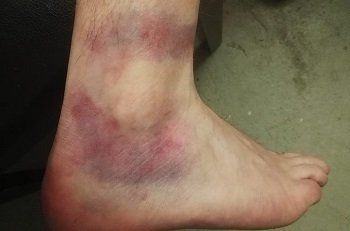Bruises
Bruises and sprains
Bruises and sprains
First off, bruises and sprains are basically the same thing. In particular, the place and manner of origin are different. Sprains occur in joints and bruises can occur throughout the body. In addition, a bruise can occur on a joint, but a sprain cannot occur anywhere other than a joint. Let's take a closer look at bruises and sprains.Bruises are damage to the tissue between the top layer (epidermis) of the skin and the bones. The epidermis is not damaged and no wound is visible. The damaged tissues can be muscles, tendons, subcutaneous connective tissue and other tissues. If these tissues are damaged, fluid and blood are released through broken blood vessels and cells. This causes swelling and the increased pressure pinches nerves. This causes pain. If you press on the bruise, the pressure on the nerves increases and you therefore feel more pain. Origin and healing Bruises always occur due to an external cause. Common bruises are on the forearm, lower leg or face. Bruised ribs are also quite common. Kneizings can be caused by bumps, falls and the like. Recovery usually takes 3 to 5 weeks. A bruise and ... Bump due to bruise Bruises can also occur in combination with other wounds. If you fall on a knee, in addition to a wound, a bruise may also occur. A bump on the forehead may indicate a concussion or even spinal injury. So always check for other injuries.SprainSprain (sprain) only occurs in joints. This is because a sprain does not occur from the outside, but because a joint makes a forced movement. This stretches and damages tissues and ligaments. The bone is not damaged. Furthermore, the same thing happens with a sprain as with a bruise. Blood and fluid cause swelling and therefore pressure on the nerves. Movement of the joint becomes more difficult and painful. Origin of sprainSprain is damage to tissue around a joint. The damage is caused by incorrect movement of the joint. Think of the ankle when you step, an incorrect movement of the knee or a wrist that bends too far when absorbing a fall. How can you recognize a bruise or sprain? Bruising or spraining damages the subcutaneous tissue. Blood vessels break. This causes subcutaneous bleeding. This produces a blue discoloration. The so-called bruise. Swelling may also occur. This swelling is caused by moisture. The moisture does not cause discoloration. Pressing on the bruise or sprain worsens the pain. After a few days, the swelling decreases again. The symptoms of a bruise or sprain are sometimes very similar to those of a bone fracture. If in doubt, an X-ray in the hospital can provide clarity. This photo can only be taken after referral from a doctor. Are you unsure whether to judge between a bruise/sprain or a fracture? Then assume a fracture and have a doctor prove otherwise (or not, of course).
ADDRESS
Physiotherapy Feyk Hogenbirk
Gezellenlaan 21
7005 AX Doetinchem
(Free parking)
T 0314 394 222
M 0653669587
info@fysiotherapiedoetinchem.com
OPENING HOURS
- Monday
- -
- Tuesday
- -
- Wednesday
- -
- Thursday
- -
- Friday
- -
- Saturday
- Appointment only
- Sunday
- Appointment only
© 2025
All rights reserved | Disclaimer | Privacy | Website by Internet agency Doetinchem FrankBrinks.nl





